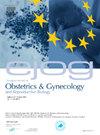Evaluation of the quality and reliability of YouTube videos on obstetric perineal tears
IF 2.1
4区 医学
Q2 OBSTETRICS & GYNECOLOGY
European journal of obstetrics, gynecology, and reproductive biology
Pub Date : 2025-03-07
DOI:10.1016/j.ejogrb.2025.03.008
引用次数: 0
Abstract
Objective
The aim of this study was to assess the quality and reliability of YouTube videos on obstetric perineal tears.
Method
We chose six keywords: “tearing birth”, “perineal trauma”, “perineal laceration”, “perineal tear”, “obstetrical anal sphincter injuries (OASIS)” and “vaginal tear”. Each video that met the inclusion criteria were analyzed by two independent raters. Quantitative and qualitative metrics were recorded and scored using the DISCERN instrument.
Results
A total of 51 videos were included. The mean overall DISCERN score between the two raters was 44.5 ± 13.6. There was no significant difference between the two raters (43.4 vs 45.6; p = 0.4). The DISCERN sore was statistically higher in videos presented by a physician (p < 0.001) and those that included an explanation of symptoms (p < 0.001).
Conclusion
YouTube videos on obstetric perineal tears have only been rated as fairly reliable. We identified the top four videos using the validated DISCERN instrument.
Our top four best videos were unpopular because they used medical terms, narrated by physician and the duration was long. Thus, they would be more appropriate to a medical cohort.
YouTube videos should be improved to better explain obstetric perineal tears to the public.
求助全文
约1分钟内获得全文
求助全文
来源期刊
CiteScore
4.60
自引率
3.80%
发文量
898
审稿时长
8.3 weeks
期刊介绍:
The European Journal of Obstetrics & Gynecology and Reproductive Biology is the leading general clinical journal covering the continent. It publishes peer reviewed original research articles, as well as a wide range of news, book reviews, biographical, historical and educational articles and a lively correspondence section. Fields covered include obstetrics, prenatal diagnosis, maternal-fetal medicine, perinatology, general gynecology, gynecologic oncology, uro-gynecology, reproductive medicine, infertility, reproductive endocrinology, sexual medicine and reproductive ethics. The European Journal of Obstetrics & Gynecology and Reproductive Biology provides a forum for scientific and clinical professional communication in obstetrics and gynecology throughout Europe and the world.

 求助内容:
求助内容: 应助结果提醒方式:
应助结果提醒方式:


